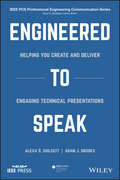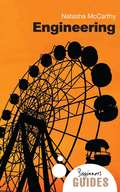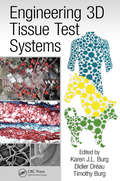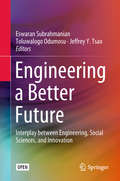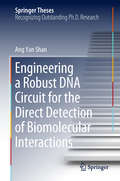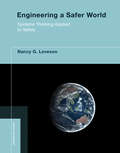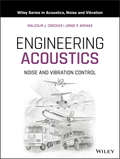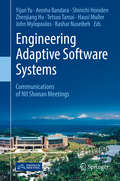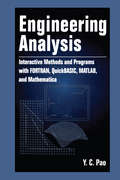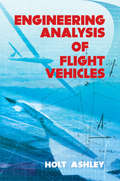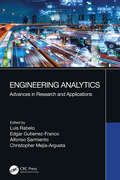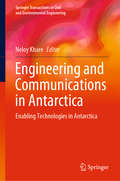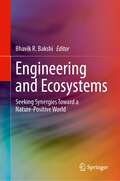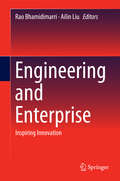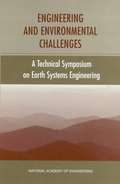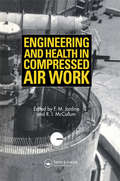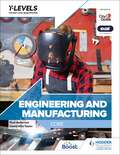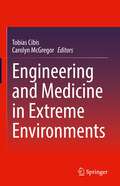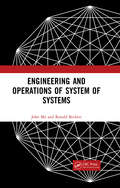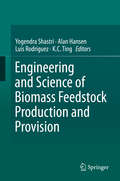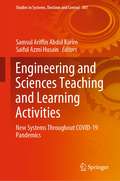- Table View
- List View
Engineered to Speak: Helping You Create and Deliver Engaging Technical Presentations (IEEE PCS Professional Engineering Communication Series)
by Alexa S. Chilcutt Adam J. BrooksEngineered to Speak: Helping You Create and Deliver Engaging Technical Presentations Technical expertise alone is not enough to ensure professional success. Twenty-first century engineers and technical professionals must master making the complex simple and the simple interesting. This book helps engineers do what they love most: take a complicated system and create a stronger solution. You will learn tips and strategies that help you answer one essential question, “How can I get better at sharing my ideas with a variety of audiences?” In Engineered to Speak, Alexa Chilcutt and Adam Brooks combine their expertise in messaging and public speaking with research that illustrates how effective communication contributes to career advancement. Each chapter contains inspiring stories from practicing engineers around the world as well as useful examples, exercises and repeatable processes for creating compelling messages. This book helps technical talent become better speakers, better communicators, and ultimately better leaders. This helpful guide demystifies the art of oral communication by breaking it down into ten easy-to-follow-processes that can improve the ability of professionals at any level. By the end of Engineered to Speak, you’ll understand how to gain buy-in, identify and expand your Sphere of Influence, amplify your message, deliver compelling presentations, and learn from those who’ve embrace these skills and enjoyed professional success.
Engineering: A Beginner's Guide (Beginner's Guides #15)
by Natasha MccarthyEngineering is more than nuts and bolts, bricks and mortar; more than the tangible evidence of man-made solutions, and imaginative buildings. McCarthy reveals how every aspect of our lives has been engineered: from how we travel and communicate to our very means of survival. Natasha McCarthy is policy advisor at the Royal Academy of Engineering, UK.
Engineering 3D Tissue Test Systems
by Karen J. L. Burg, Didier Dréau and Timothy BurgEngineering 3D Tissue Test Systems provides an introduction to, and unique coverage of, a rapidly evolving area in biomaterials engineering. It reveals the current and future research responses, the current and future diagnostic applications, and provides a comprehensive overview to foster innovation. It offers insight into the importance of 3D systems and their use as benchtop models, spanning applications from basic scientific research to clinical diagnostics. Methods and limitations of building 3D tissue structures are evaluated, with attention given to the cellular, polymeric, and fabrication instrumentation components. The book covers the important aspects of polymeric tissue test systems, highlighting the needs and constraints of the industry, and includes a chapter on regulatory and pricing issues.
Engineering a Better Future: Interplay between Engineering, Social Sciences, and Innovation
by Eswaran Subrahmanian Toluwalogo Odumosu Jeffrey Y. TsaoThis open access book examines how the social sciences can be integrated into the praxis of engineering and science, presenting unique perspectives on the interplay between engineering and social science. Motivated by the report by the Commission on Humanities and Social Sciences of the American Association of Arts and Sciences, which emphasizes the importance of social sciences and Humanities in technical fields, the essays and papers collected in this book were presented at the NSF-funded workshop ‘Engineering a Better Future: Interplay between Engineering, Social Sciences and Innovation’, which brought together a singular collection of people, topics and disciplines. The book is split into three parts: A. Meeting at the Middle: Challenges to educating at the boundaries covers experiments in combining engineering education and the social sciences; B. Engineers Shaping Human Affairs: Investigating the interaction between social sciences and engineering, including the cult of innovation, politics of engineering, engineering design and future of societies; and C. Engineering the Engineers: Investigates thinking about design with papers on the art and science of science and engineering practice.
Engineering a Robust DNA Circuit for the Direct Detection of Biomolecular Interactions (Springer Theses)
by Ang Yan ShanThis book provides essential insights into designing a localized DNA circuit to promote the rate of desired hybridization reactions over undesired leak reactions in the bulk solution. The area of dynamic DNA nanotechnology, or DNA circuits, holds great promise as a highly programmable toolbox that can be used in various applications, including molecular computing and biomolecular detection. However, a key bottleneck is the recurring issue of circuit leakage. The assembly of the localized circuit is dynamically driven by the recognition of biomolecules – a different approach from most methods, which are based on a static DNA origami assembly. The design guidelines for individual reaction modules presented here, which focus on minimizing circuit leakage, are established through NUPACK simulation and tested experimentally – which will be useful for researchers interested in adapting the concepts for other contexts. In the closing section, the design concepts are successfully applied to the biomolecular sensing of a broad range of targets including the single nucleotide mutations, proteins, and cell surface receptors.
Engineering a Safer World: Systems Thinking Applied to Safety (Engineering Systems)
by Nancy G. LevesonA new approach to safety, based on systems thinking, that is more effective, less costly, and easier to use than current techniques.Engineering has experienced a technological revolution, but the basic engineering techniques applied in safety and reliability engineering, created in a simpler, analog world, have changed very little over the years. In this groundbreaking book, Nancy Leveson proposes a new approach to safety—more suited to today's complex, sociotechnical, software-intensive world—based on modern systems thinking and systems theory. Revisiting and updating ideas pioneered by 1950s aerospace engineers in their System Safety concept, and testing her new model extensively on real-world examples, Leveson has created a new approach to safety that is more effective, less expensive, and easier to use than current techniques.Arguing that traditional models of causality are inadequate, Leveson presents a new, extended model of causation (Systems-Theoretic Accident Model and Processes, or STAMP), then shows how the new model can be used to create techniques for system safety engineering, including accident analysis, hazard analysis, system design, safety in operations, and management of safety-critical systems. She applies the new techniques to real-world events including the friendly-fire loss of a U.S. Blackhawk helicopter in the first Gulf War; the Vioxx recall; the U.S. Navy SUBSAFE program; and the bacterial contamination of a public water supply in a Canadian town. Leveson's approach is relevant even beyond safety engineering, offering techniques for “reengineering” any large sociotechnical system to improve safety and manage risk.
Engineering Acoustics: Noise and Vibration Control (Wiley Series in Acoustics Noise and Vibration)
by Malcolm J. Crocker Jorge P. ArenasA comprehensive evaluation of the basic theory for acoustics, noise and vibration control together with fundamentals of how this theoretical material can be applied to real world problems in the control of noise and vibration in aircraft, appliances, buildings, industry, and vehicles. The basic theory is presented in elementary form and only of sufficient complication necessary to solve real practical problems. Unnecessary advanced theoretical approaches are not included. In addition to the fundamental material discussed, chapters are included on human hearing and response to noise and vibration, acoustics and vibration transducers, instrumentation, noise and vibration measurements, and practical discussions concerning: community noise and vibration, interior and exterior noise of aircraft, road and rail vehicles, machinery noise and vibration sources, noise and vibration in rapid transit rail vehicles, automobiles, trucks, off road vehicles, and ships. In addition, extensive up to date useful references are included at the end of each chapter for further reading. The book concludes with a glossary on acoustics, noise and vibration
Engineering Adaptive Software Systems: Communications Of NII Shonan Meetings (Lecture Notes In Computer Science / Programming And Software Engineering Ser. #7475)
by Yijun Yu Arosha Bandara Shinichi Honiden Zhenjiang Hu Tetsuo Tamai Hausi Muller John Mylopoulos Bashar NuseibehThis book discusses the problems and challenges in the interdisciplinary research field of self-adaptive software systems. Modern society is increasingly filled with software-intensive systems, which are required to operate in more and more dynamic and uncertain environments. These systems must monitor and control their environment while adapting to meet the requirements at runtime. This book provides promising approaches and research methods in software engineering, system engineering, and related fields to address the challenges in engineering the next-generation adaptive software systems. The contents of the book range from design and engineering principles (Chap. 1) to control–theoretic solutions (Chap. 2) and bidirectional transformations (Chap. 3), which can be seen as promising ways to implement the functional requirements of self-adaptive systems. Important quality requirements are also dealt with by these approaches: parallel adaptation for performance (Chap. 4), self-adaptive authorization infrastructure for security (Chap. 5), and self-adaptive risk assessment for self-protection (Chap. 6). Finally, Chap. 7 provides a concrete self-adaptive robotics operating system as a testbed for self-adaptive systems. The book grew out of a series of the Shonan Meetings on this ambitious topic held in 2012, 2013, and 2015. The authors were active participants in the meetings and have brought in interesting points of view. After several years of reflection, they now have been able to crystalize the ideas contained herein and collaboratively pave the way for solving some aspects of the research problems. As a result, the book stands as a milestone to initiate further progress in this promising interdisciplinary research field.
Engineering Analysis: Interactive Methods and Programs with FORTRAN, QuickBASIC, MATLAB, and Mathematica (Allyn And Bacon Series In Mechanical Engineering)
by Yen-Ching PaoThis book provides a concise introduction to numerical concepts in engineering analysis, using FORTRAN, QuickBASIC, MATLAB, and Mathematica to illustrate the examples. Discussions include:matrix algebra and analysissolution of matrix equationsmethods of curve fitmethods for finding the roots of polynom
Engineering Analysis of Flight Vehicles (Dover Books on Aeronautical Engineering)
by Holt Ashley"Written by one of the leading aerospace educators of our time, each sentence is packed with information. An outstanding book." -- Private Pilot"Illuminated throughout by new twists in explaining familiar concepts, helpful examples and intriguing 'by-the-ways.' A fine book." -- Canadian Aeronautics and Space JournalThis classic by a Stanford University educator and a pioneer of aerospace engineering introduces the complex process of designing atmospheric flight vehicles. An exploration of virtually every important subject in the fields of subsonic, transonic, supersonic, and hypersonic aerodynamics and dynamics, the text demonstrates how these topics interface and how they complement one another in atmospheric flight vehicle design. The mathematically rigorous treatment is geared toward graduate-level students, and it also serves as an excellent reference. Problems at the end of each chapter encourage further investigation of the text's material, the study of fresh ideas, and the exploration of new areas.
Engineering Analytics: Advances in Research and Applications
by Luis RabeloEngineering analytics is becoming a necessary skill for every engineer. Areas such as Operations Research, Simulation, and Machine Learning can be totally transformed through massive volumes of data. This book is intended to be an introduction to Engineering Analytics that can be used to improve performance tracking, customer segmentation for resource optimization, patterns and classification strategies, and logistics control towers. Basic methods in the areas of visual, descriptive, predictive, and prescriptive analytics and Big Data are introduced. Industrial case studies and example problem demonstrations are used throughout the book to reinforce the concepts and applications. The book goes on to cover visual analytics and its relationships, simulation from the respective dimensions and Machine Learning and Artificial Intelligence from different paradigms viewpoints. The book is intended for professionals wanting to work on analytical problems, for Engineering students, Researchers, Chief-Technology Officers, and Directors that work within the areas and fields of Industrial Engineering, Computer Science, Statistics, Electrical Engineering Operations Research, and Big Data.
Engineering and Communications in Antarctica: Enabling Technologies in Antarctica (Springer Transactions in Civil and Environmental Engineering)
by Neloy KhareIndia launched its maiden scientific expedition to Antarctica way back in 1981 and ever since annual expeditions are launched to address thematic research in the contemporary areas of Antarctic Science and Engineering. The initial efforts and achievements of India are not only significant but are of historical importance.This book discusses a wide array of topics that have entered the mainstream of geotechnical and geo environmental engineering over the initial two and half decades of India’s presence in the icy continent ‘Antarctica’. At the same time, it highlights the lessons learnt in cryo-engineering technologies. It covers various articles on many aspects of environmental science and collates the overall achievements in the fascinating field of Antarctic engineering and environmental impact assessment. Accordingly, this book covers articles on wind energy by Ramesh et al., and engineering aspects in Antarctica by Rai. Similarly, Pathak has reviewed the engineering details of Dakshin Gangotri and Maitri. On the contrary, Sharma has provided an interesting history about the process of establishment of Dakshin Gangotri station. Similarly, communication aspects have been highlighted by Dhaka. Commercial polymers and their utility in cold region have been discussed by Dabholker et al. Besides, Tiwari and Khare have reviewed the environmental studies carried out during the initial 25 years in Antarctic research base ‘Maitri’. Similarly, Ramchandran and Sathe have studied the natural radioactivity in Antarctica while fire safety in Antarctica has been touched upon by Chatterjee. On the other hand, Veerbhadraiah and Jain have provided a status on environmental management services at Maitri station Additionally Tiwari has provided details on the new Indian Research Base ‘Bharti’ at Larsemann Hills region. It provides a one-stop reference for researchers and those working in industry and government.
Engineering and Ecosystems: Seeking Synergies Toward a Nature-Positive World
by Bhavik R. BakshiThis book demonstrates how the inclusion of nature in engineering decisions results in innovative solutions that are economically feasible, ecologically viable, and socially desirable. It advances progress toward nature-positive decisions by protection and restoration of ecosystems and respect for ecological boundaries. The topic of this book is an active area of academic research, and leading companies are including goals associated with ecosystem services in their sustainability plans. This book is the first collection of methods and applications that explicitly include the role of nature in supporting engineering activities and describes the role that ecosystems play in supporting technology and industry. It describes approaches, models, applications, and challenges for innovation and sustainability that will be useful to students and practitioners.
Engineering and Enterprise
by Rao Bhamidimarri Ailin LiuThis book presents contributions from researchers, practitioners and professional institutions that published papers in the Proceedings of the Educating Enterprising Engineers and Scientists conference, held in London, UK on 17th June 2015. The topics considered range from educating engineers to giving a business edge and embedding entrepreneurship to achieve integrated education and curriculum innovation. Making an important contribution to the development and delivery of engineering education now and further into the future, this collection of papers shares knowledge and good practice in key ways to educate enterprising engineers and scientists looking to address complex global issues such as health & well-being, water, energy and food. Seeking ways to redefine and embrace sustainable development, this work puts forward the case for innovative science and engineering education to meet the demand for talent and leadership.
Engineering And Environmental Challenges: Technical Symposium On Earth Systems Engineering
by National Academy of Engineering Staff National Academy of Engineering Annual Meeting StaffDealing with the challenges presented by climate change or rapid urban development require cooperation and expertise from engineering, social and natural sciences. Earth systems engineering is an emerging area of multidisclinary study that takes a holistic view of natural and human system interactions to better understand complex systems. It seeks to develop methods and tools that enable technically sound and ethically wise decisions. Engineering and Environmental Challenges presents the proceedings of a National Academy of Engineering public symposium on Earth systems engineering.
Engineering and Health in Compressed Air Work: Proceedings of the International Conference, Oxford, September 1992
by F. M. Jardine R. I. McCallumThis book is the record of the conference held in Oxford in 1992 organised by CIRIA, and co-sponsored by the Health and Safety Executive, The British Tunnelling Society and the Medical Research Council's Hyperbaric Sciences Panel. The book consolidates international medical and engineering knowledge and experience on the use of compressed air and hyperbaric techniques, and looks to how they can be safely used in the future.
Engineering and Manufacturing T Level: Core
by Paul Anderson David Hills-Taylor Andrew Topliss C.J. Polly Booker Andrew BuckenhamTackle the core component of your Engineering and Manufacturing T Level with this comprehensive resource published in association with City & Guilds and EAL.With topics ranging from essential maths and science to mechanical, electrical and electronic principles and engineering project management, this clear and accessible textbook will guide you through the qualification's core unit and will equip you with a solid understanding of the key principles, concepts, theories and skills you need to shape your career in engineering and manufacturing. - Track and strengthen your knowledge using learning outcomes at the beginning of every chapter and 'Test Yourself' questions throughout.- Improve your understanding of important terminology with a 'Key Terms' feature, as well as a detailed glossary. - Contextualise your learning with real-world case studies that explore some of the dilemmas you can expect to face in the workplace and reflection tasks to ensure you are set up for success. - Understand how to avoid hazards and minimise risk with regular health and safety reminders.- Prepare for your exams and the Employer Set Project using tips, assessment practice and model answers. - Build the functional skills you need to thrive in the industry with English and maths exercises.- Develop your professional skills with helpful tips from expert authors Paul Anderson and David Hills-Taylor, who draw on their extensive teaching and industry experience.
Engineering and Manufacturing T Level: Core
by Paul Anderson David Hills-Taylor Andrew Topliss C.J. Polly Booker Andrew BuckenhamTackle the core component of your Engineering and Manufacturing T Level with this comprehensive resource published in association with City & Guilds and EAL.With topics ranging from essential maths and science to mechanical, electrical and electronic principles and engineering project management, this clear and accessible textbook will guide you through the qualification's core unit and will equip you with a solid understanding of the key principles, concepts, theories and skills you need to shape your career in engineering and manufacturing. - Track and strengthen your knowledge using learning outcomes at the beginning of every chapter and 'Test Yourself' questions throughout.- Improve your understanding of important terminology with a 'Key Terms' feature, as well as a detailed glossary. - Contextualise your learning with real-world case studies that explore some of the dilemmas you can expect to face in the workplace and reflection tasks to ensure you are set up for success. - Understand how to avoid hazards and minimise risk with regular health and safety reminders.- Prepare for your exams and the Employer Set Project using tips, assessment practice and model answers. - Build the functional skills you need to thrive in the industry with English and maths exercises.- Develop your professional skills with helpful tips from expert authors Paul Anderson and David Hills-Taylor, who draw on their extensive teaching and industry experience.
Engineering and Medicine in Extreme Environments
by Tobias Cibis Carolyn McGregor AmThis book brings together in-depth information on a wide array of bio-engineering topics and their application to enhance human health, performance, comfort, and survival in extreme environments. Contributions from biomedical engineering, information systems, medicine and physiology, and medical engineering are presented in relation to a broad range of harsh and extreme environmental scenarios, including underwater, terrestrial (both natural and man-made), and space travel. Physicians, engineers, and scientists, as well as researchers and graduate students, will find the book to be an invaluable resource.Details effects of extreme environments on human physiology;Presents human-environment interaction in different scenarios;Overview of engineering challenges and problems in extreme environments.
Engineering and Operations of System of Systems
by John Mo Ronald BeckettModern engineering systems are complex and multi-faceted, and must be flexible, adaptable, and fully integrated with the supply chain and other stakeholders to deliver an effective level of performance. Therefore, this book aims to create an operational view and new understanding of modern system design, commissioning, operation, services and support. It includes system of systems modelling and analysis techniques essential to develop whole of system in view of essential requirements. This book will address professional engineers/operations managers required to design, develop, implement and operate a complex socio-technical system containing many engineering systems. Key Features • Develops a holistic view of system of systems from all possible fields of interest • Introduces the idea of system configurability to understand system of systems in parallel with the typical, classical concepts of engineering systems design • Offers effective coverage of both the engineering aspects and operational aspects of systems of systems • Focuses on pragmatic viewpoints on how to analyze system of systems • Provides practical tools and methods for the readers to develop competence to configure and operate system of systems
Engineering and Product Development Management: The Holistic Approach
by Stephen C. ArmstrongThis practical guide to the components of engineering management employs a holistic approach. It will help engineers and managers understand how to improve the product development process by deploying new technology and new methods of working in concurrent teams. The book integrates elements from six well-known and understood bodies of knowledge: integrated product development, project management, process management, systems engineering, product data management, and organizational change management. These elements are framed within an overall enterprise-wide architecture. The techniques discussed work for both huge multinational organizations and smaller enterprises. The emphasis throughout is on practical tools for engineers, managers, and consultants responsible for project and product development.
Engineering and Science of Biomass Feedstock Production and Provision
by Yogendra Shastri Alan Hansen Luis Rodríguez K. C. TingThe biomass based energy sector, especially the one based on lignocellulosic sources such as switchgrass Miscanthus, forest residues and short rotation coppice, will play an important role in our drive towards renewable energy. The biomass feedstock production (BFP) subsystem provides the necessary material inputs to the conversion processes for energy production. This subsystem includes the agronomic production of energy crops and the physical handling and delivery of biomass, as well as other enabling logistics. Achieving a sustainable BFP system is therefore paramount for the success of the emerging bioenergy sector. However, low bulk and energy densities, seasonal and weather sensitive availability, distributed supply and lack of commercial scale production experience create unique challenges. Moreover, novel region specific feedstock alternatives continue to emerge. Engineering will play a critical role in addressing these challenges and ensuring the techno-economic feasibility of this sector. It must also integrate with the biological, physical and chemical sciences and incorporate externalities, such as social/economic considerations, environmental impact and policy/regulatory issues, to achieve a truly sustainable system. Tremendous progress has been made in the past few years while new challenges have simultaneously emerged that need further investigation. It is therefore prudent at this time to review the current status and capture the future challenges through a comprehensive book. This work will serve as an authoritative treatise on the topic that can help researchers, educators and students interested in the field of biomass feedstock production, with particular interest in the engineering aspects.
Engineering and Sciences Teaching and Learning Activities: New Systems Throughout COVID-19 Pandemics (Studies in Systems, Decision and Control #381)
by Samsul Ariffin Abdul Karim Saiful Azmi HusainThis book comes from genuine research from various universities in Asia, such as in South East Asia and India. Since COVID-19 pandemic is spreading all over the world, most schools and institutions of higher learning have opted online-based learning for their teaching and learning (T&L) activities. Previously, the common practices in T&L are face to face (F2F). Therefore, online T&L is a new normal not just for the students but also for the instructors as well as the parents. In this book, different online teaching methods via technology-supported teaching have been implemented, and at the end of the lesson, based on the feedback from students on these online technology-supported teaching tools, most educators found that there are positive responses from majority of students, in terms of their learning, attitudes, thinking and decision-making process, apart from the challenges faced by the students in the beginning, with regards to the new approaches and methodology used by their teachers during online teaching. There are eight contributed chapters in this book covering secondary school-level curriculum up to higher institutional-level curriculum that forming a new system of T&L for post-COVID-19 pandemic. The topics under consideration include active learning (AL) and cooperative learning (CL) for T&L, task-based instruction (TBI), transition students’ adaptability to post-COVID-19, creative and innovative teaching methods for secondary school-level mathematics, project-based learning (PPBL) for geophysics and impact of Socratic method and SOLO taxonomy. This book is suitable for postgraduate students, teachers, instructor, educational researchers, as well as policy makers in education and other scientists who are dedicated in teaching and educate students.
Engineering And Technology Education: Learning By Design
by Michael Hacker David BurghardtEngineering and Technology Education: Learning by Design.
Engineering And Technology Education: Learning By Design
by Michael Hacker David BurghardtEngineering AND Technology Education Learning by Design
